Crypto investor protection has evolved from an oxymoron into a legitimate regulatory framework, combining traditional safeguards like KYC requirements and AML compliance with innovative measures including regulatory sandboxes and hardware wallet security protocols. The irony remains palpable: an industry built on distrust of centralized authority now actively seeks institutional oversight, while investors must navigate Travel Rule mandates, stablecoin regulations, and persistent security vulnerabilities through exchanges that function as digital fortresses—though further exploration reveals additional complexities.

The cryptocurrency landscape presents investors with a peculiar paradox: an asset class born from distrust of traditional financial institutions now desperately seeks the very regulatory protections those institutions have long enjoyed.
Crypto’s greatest irony: rebels against banking regulation now beg for the same institutional protections they once scorned.
This ironic reversal has spawned a complex web of emerging safeguards that attempt to reconcile decentralized innovation with centralized oversight—a task roughly equivalent to herding digital cats.
Anti-money laundering (AML) and countering the financing of terrorism (CFT) requirements now form the backbone of crypto investor protection, ensuring platforms maintain compliance standards that would make traditional banks weep with recognition.
The Travel Rule adds another layer, mandating Virtual Asset Service Providers collect personally identifiable information for transactions exceeding $3,000—because apparently even pseudonymous transactions need proper introductions.
Know Your Customer (KYC) practices have become as essential to crypto as private keys, verifying identities with the same fervor once reserved for speakeasy passwords.
Meanwhile, regulatory sandboxes offer a fascinating compromise: controlled environments where businesses can test innovative products under watchful regulatory eyes, like financial playpens for grown-up entrepreneurs.
Legislative developments continue reshaping the landscape, with thorough stablecoin regulation emerging as a priority.
These measures aim to provide clear legal frameworks—a concept that feels revolutionary in an industry built on code rather than case law.
Practical investor safety measures extend beyond regulatory compliance.
Secure exchanges serve as digital fortresses (though history suggests some have moats filled with crocodiles), while cold storage solutions protect against the perpetual threat of hacking.
Investment diversification across different cryptocurrencies offers risk mitigation, though diversifying among volatile assets presents its own philosophical challenges.
Beyond exchange security, investors must implement comprehensive hardware wallets and proper private key management to maintain control over their digital assets.
The current administration’s hands-off approach encourages innovation while raising legitimate oversight concerns—a delicate balance between fostering growth and preventing financial chaos. Trump’s recent executive order declared crypto a national priority while establishing frameworks for responsible digital asset growth.
Industry collaboration between regulators and businesses has become essential, though whether this represents genuine partnership or reluctant coexistence remains debatable.
Regulatory uncertainty continues plaguing investors, compounded by market volatility that makes traditional assets appear sedate by comparison. The SEC’s recent decision to drop major lawsuits against prominent crypto companies like Gemini and Coinbase signals a shift toward reduced enforcement intensity.
Security risks persist alongside market manipulation threats, creating an environment where education becomes investors’ most valuable protection—assuming they can navigate the labyrinthine regulatory landscape long enough to acquire it.
Frequently Asked Questions
What Happens to My Crypto if the Exchange Gets Hacked?
When exchanges suffer breaches, investors typically face substantial losses—recovery remains frustratingly elusive despite blockchain’s supposed transparency.
While some platforms offer insurance coverage (often inadequately limited), most victims discover their assets have vanished into the digital ether.
The exchange may compensate users from reserves or declare bankruptcy, following Mt. Gox’s infamous precedent.
Ironically, decentralized finance’s promise of eliminating intermediaries highlights why centralized custody creates these vulnerabilities in the first place.
Are Cryptocurrency Investments Covered by FDIC Insurance?
Cryptocurrency investments remain conspicuously outside FDIC insurance coverage, regardless of exchange marketing claims suggesting otherwise.
The $250,000 federal protection applies exclusively to traditional bank deposits—not digital assets held by non-bank platforms.
When crypto exchanges collapse (a disturbingly frequent occurrence), investors face total loss without recourse.
Unlike the previously discussed hacking scenarios, this represents systematic regulatory exclusion rather than mere security failure, leaving crypto holders entirely dependent on platform solvency.
How Can I Recover Funds Sent to the Wrong Wallet Address?
Recovering misdirected cryptocurrency requires immediate action—contact known recipients directly, reach out to exchange support if funds landed at trading platforms, or engage professional recovery services like CipherBlade.
Cross-chain tools may salvage funds sent to incompatible networks, assuming one possesses compatible wallet access.
Prevention remains superior: verify addresses character-by-character, conduct small test transfers, and utilize multi-chain wallets that flag common errors before irreversible blockchain confirmation occurs.
What Legal Recourse Do I Have Against Fraudulent Crypto Projects?
Victims of fraudulent crypto projects can pursue legal recourse through SEC complaints and potential whistleblower claims (offering 10-30% awards from recovered funds).
However, recovering stolen assets remains notoriously difficult—particularly given jurisdictional complexities when scammers operate internationally.
State agencies like California’s DFPI provide additional reporting mechanisms, though unlike traditional financial fraud, crypto transactions lack standard consumer protections, making prevention infinitely more valuable than attempted remediation.
Should I Use a Hardware Wallet or Keep Crypto on Exchanges?
Hardware wallets provide superior security through offline private key storage, eliminating exchange counterparty risk—though one must actually use them correctly (shocking, really).
Exchanges offer trading convenience but transform users into unsecured creditors of centralized platforms.
The prudent approach involves hardware wallets for long-term holdings and minimal exchange balances for active trading.
Given fraudulent projects discussed previously, self-custody becomes even more critical for asset protection.









